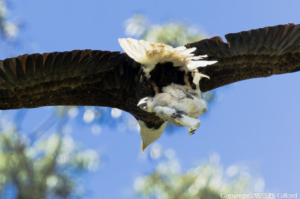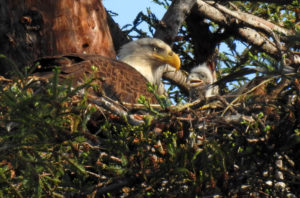On July 10, 2009, Pinnacles National Monument staff lifted seasonal rock climbing closures on several rock formations that close each year to protect nesting raptors. For the last 23 years, park staff have closed routes to climbers to allow the birds to nest undisturbed.
“Generally folks are pretty supportive of the program,” says Gavin Emmons, a biological science technician and raptor biologist at the monument. Emmons is also a climber himself. “I am pretty careful to communicate with groups such as Friends of the Pinnacles to keep an open line with the local climbing community. I try to balance the needs of the birds and maintaining the national park’s mandate while respecting the needs and concerns of the climbers.”
The current policy of closing the nesting areas was born in 1986 when two climbers came across raptors nesting. The birds immediately became flustered and abandoned their nest. When the park staff learned about this from the climbers, they closed the park completely to climbing.
The local climbing community objected and threatened a lawsuit against the park, arguing that it was unfair and unnecessary to close the whole park to climbing without any research on the birds’ nesting patterns. In the wake of that controversy, Pinnacles staff began to monitor the birds and agreed to issue advisory closings on important nesting areas, as long as such closures were respected by the climbers.
Today, Emmons works closely with organizations like Friends of Pinnacles, a local climbing group that seeks to keep the park open to climbing, and the Access Fund, a national climbing group involved in the original lawsuit threat.
Early in the season, the whole park is closed to climbing, until birds have chosen their nesting spots. In January, biologists use observations of raptor nesting patterns to determine which areas need to be closed for the coming nesting season. But it’s not just a matter of spotting a nest. Biologists first look for territorial behavior: Males conduct swooping dives around the area in which they’ve staked claim to intimidate other males in the area. Looking for courtship behavior is also an important sign to the biologists that the birds are nesting in an area.
After biologists figure out which areas the raptors have chosen, the blanket advisory is lifted and areas with no nesting raptors are re-opened for climbing. Then around the beginning of July, the raptor chicks have fledged and all climbing areas are re-opened to the public.
While other variables such as the availability of prey play a big role in the raptors’ reproductive success each year, it’s also important to monitor the birds’ nesting patterns and maintain closures to allow the birds to be undisturbed. Over the last 23 years the program has produced on average 26.67 total fledglings per year, with 18.42 fledglings from nests in historic climbing areas in the park. The numbers of fledglings produced from climbing areas is significant in that it represents the majority of fledglings in the park each season, highlighting both the need for the program for the birds wellbeing, while also showing the consistent success of the program throughout its existence.
An average of 3.25 fledglings per nest has remained constant for both nests in historic climbing areas and those that are in remote areas of the park. The numbers of fledglings per nest is especially significant because normal nesting rates fall around three to four fledglings per nest. The park’s program has allowed for raptor productivity to remain healthy and at constant rates compared to other raptor nesting populations studied outside of Pinnacles National Monument.
For more information about hiking or climbing at the Pinnacles National Monument visit the park’s website. For more on Friends of Pinnacles and the AccessFund visit their websites at http://www.pinnacles.org/ and http://www.accessfund.org.

.jpg)



